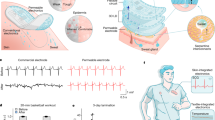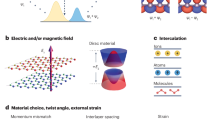Abstract
Electronic skin devices capable of monitoring physiological signals and displaying feedback information through closed-loop communication between the user and electronics are being considered for next-generation wearables and the ‘Internet of Things’. Such devices need to be ultrathin to achieve seamless and conformal contact with the human body, to accommodate strains from repeated movement and to be comfortable to wear. Recently, self-healing chemistry has driven important advances in deformable and reconfigurable electronics, particularly with self-healable electrodes as the key enabler. Unlike polymer substrates with self-healable dynamic nature, the disrupted conducting network is unable to recover its stretchability after damage. Here, we report the observation of self-reconstruction of conducting nanostructures when in contact with a dynamically crosslinked polymer network. This, combined with the self-bonding property of self-healing polymer, allowed subsequent heterogeneous multi-component device integration of interconnects, sensors and light-emitting devices into a single multi-functional system. This first autonomous self-healable and stretchable multi-component electronic skin paves the way for future robust electronics.
This is a preview of subscription content, access via your institution
Access options
Access Nature and 54 other Nature Portfolio journals
Get Nature+, our best-value online-access subscription
$29.99 / 30 days
cancel any time
Subscribe to this journal
Receive 12 print issues and online access
$259.00 per year
only $21.58 per issue
Buy this article
- Purchase on Springer Link
- Instant access to full article PDF
Prices may be subject to local taxes which are calculated during checkout






Similar content being viewed by others
References
Kim, D.-H. et al. Epidermal electronics. Science 333, 838–843 (2011).
Son, D. et al. Multifunctional wearable devices for diagnosis and therapy of movement disorders. Nat. Nanotech. 9, 397–404 (2014).
Kaltenbrunner, M. et al. An ultra-lightweight design for imperceptible plastic electronics. Nature 499, 458–463 (2013).
Gao, W. et al. Fully integrated wearable sensor arrays for multiplexed in situ perspiration analysis. Nature 529, 509–514 (2016).
Yu, B. et al. An elastic second skin. Nat. Mater. 15, 911–918 (2016).
Chortos, A., Liu, J. & Bao, Z. Pursuing prosthetic electronic skin. Nat. Mater. 15, 937–950 (2016).
Kim, D.-H. et al. Materials for multifunctional balloon catheters with capabilities in cardiac electrophysiological mapping and ablation therapy. Nat. Mater. 10, 316–323 (2011).
Oh, J. Y. et al. Intrinsically stretchable and healable semiconducting polymer for organic transistors. Nature 539, 411–415 (2016).
Ma, R. et al. Highly efficient electrocaloric cooling with electrostatic actuation. Science 357, 1130–1134 (2017).
Liang, J., Li, L., Niu, X., Yu, Z. & Pei, Q. Elastomeric polymer light-emitting devices and displays. Nat. Photon. 7, 817–824 (2013).
Matsuhisa, N. et al. Printable elastic conductors by in situ formation of silver nanoparticles from silver flakes. Nat. Mater. 16, 834–840 (2017).
Park, M. et al. Highly stretchable electric circuits from a composite material of silver nanoparticles and elastomeric fibres. Nat. Nanotech. 7, 803–809 (2012).
Sun, J.-Y. et al. Highly stretchable and tough hydrogels. Nature 489, 133–136 (2016).
Yuk, H., Zhang, T., Parada, G. A., Liu, X. & Zhao, X. Skin-inspired hydrogel–elastomer hybrids with robust interfaces and functional microstructures. Nat. Commun. 7, 12028 (2016).
Savagatrup, S. et al. Plasticization of PEDOT:PSS by common additives for mechanically robust organic solar cells and wearable sensors. Adv. Funct. Mater. 25, 427–436 (2015).
Zhao, H., O’brien, K., Li, S. & Shepherd, R. F. Optoelectronically innervated soft prosthetic hand via stretchable optical waveguides. Sci. Robot. 1, eaai7529 (2016).
Xu, J. et al. Highly stretchable polymer semiconductor films through the nanoconfinement effect. Science 355, 59–64 (2017).
Yang, Y. & Urban, M. W. Self-healing polymeric materials. Chem. Soc. Rev. 42, 7446–7467 (2013).
Holten-Andersen, N. et al. pH-induced metal-ligand cross-links inspired by mussel yield self-healing polymer networks with near-covalent elastic moduli. Proc. Natl Acad. Sci. USA 108, 2651–2655 (2011).
Yuan, L. et al. Poly(phenylene oxide) modified cyanate resin for self-healing. Polym. Adv. Technol. 25, 752–759 (2014).
Li, C.-H. et al. A highly stretchable autonomous self-healing elastomer. Nature Chem. 8, 618–624 (2016).
Huang, Y. et al. A self-healable and highly stretchable supercapacitor based on a dual crosslinked polyelectrolyte. Nat. Commun. 6, 10310 (2015).
Gong, C. et al. A healable, semitransparent silver nanowire–polymer composite conductor. Adv. Mater. 25, 4186–4191 (2013).
Li, J. et al. Healable capacitive touch screen sensors based on transparent composite electrodes comprising silver nanowires and a furan/maleimide Diels–Alder cycloaddition polymer. ACS Nano 8, 12874–12882 (2014).
Wang, H. et al. A mechanically and electrically self-healing supercapacitor. Adv. Mater. 26, 3638–3643 (2014).
Bandodkar, A. J. et al. All-printed magnetically self-healing electrochemical devices. Sci. Adv. 2, e1601465 (2016).
Huynh, T.-P. & Haick, H. Self-healing, fully functional, and multiparametric flexible sensing platform. Adv. Mater. 28, 138–143 (2016).
Cordier, P., Tournilhac, F., Soulie-Ziakovic, C. & Leibler, L. Self-healing and thermoreversible rubber from supramolecular assembly. Nature 451, 977–980 (2008).
Zou, Z. et al. Rehealable, fully recyclable, and malleable electronic skin enabled by dynamic covalent thermoset nanocomposite. Sci. Adv. 4, eaaq0508 (2018).
Palleau, E. et al. Self-healing stretchable wires for reconfigurable circuit wiring and 3D microfluidics. Adv. Mater. 25, 1589–1592 (2013).
Kang, J. et al. Tough and water-insensitive self-healing elastomer for robust electronic skin. Adv. Mater. 30, 1706846 (2018).
De Greef, T. F. A. et al. Supramolecular polymerization. Chem. Rev. 109, 5687–5754 (2009).
Kim, S. M. et al. Role of anions in the AuCl3-doping of carbon nanotubes. ACS Nano 5, 1236–1242 (2011).
Lipomi, D. J. et al. Skin-like pressure and strain sensors based on transparent elastic films of carbon nanotubes. Nat. Nanotech. 6, 788–792 (2011).
Wallace, W. E. et al. Polymer chain relaxation: surface outpaces bulk. Macromolecules 34, 5081–5082 (2001).
Larson, C. et al. Highly stretchable electroluminescent skin for optical signaling and tactile sensing. Science 351, 1071–1074 (2016).
Yang, C. H. et al. Electroluminescence of giant stretchability. Adv. Mater. 28, 4480–4484 (2016).
Acknowledgements
This work was supported by Samsung Electronics. This work was partially performed at the Stanford Nano Shared Facilities (SNSF), supported by the National Science Foundation under award ECCS-1542152. O.V. was supported by the Swiss National Science Foundation ‘Mobility Fellowship’ P2ELP2_165147.
Author information
Authors and Affiliations
Contributions
D.S., J.K., O.V. and Z.B. designed the experiments. D.S., J.K., O.V., N.M., Y.K., J.Y.O., J.W.T., J.M., T.K., Y.L., A.F.M., M.K., F.M.L., J.H., U.K., Y.L., Y.Y., J.B.-H.T. and Z.B. performed experiments and carried out analysis. D.S., J.K., O.V., J.B.-H.T. and Z.B. wrote the manuscript.
Corresponding author
Ethics declarations
Competing interests
The authors declare no competing interests.
Additional information
Publisher’s note: Springer Nature remains neutral with regard to jurisdictional claims in published maps and institutional affiliations.
Supplementary information
Supplementary Information
Supplementary Figures 1–27, Supplementary References
Supplementary Video 1
Stretchable self-healing interconnection for commercial LEDs and passive modules
Supplementary Video 2
ECG sensor with autonomous self-healability (1)
Supplementary Video 3
ECG sensor with autonomous self-healability (2)
Supplementary Video 4
Integrated electroluminescent skin with ECG sensor (1)
Supplementary Video 5
Integrated electroluminescent skin with ECG sensor (2)
Rights and permissions
About this article
Cite this article
Son, D., Kang, J., Vardoulis, O. et al. An integrated self-healable electronic skin system fabricated via dynamic reconstruction of a nanostructured conducting network. Nature Nanotech 13, 1057–1065 (2018). https://doi.org/10.1038/s41565-018-0244-6
Received:
Accepted:
Published:
Issue Date:
DOI: https://doi.org/10.1038/s41565-018-0244-6
This article is cited by
-
Breathable and wearable graphene/waterborne polyurethane coated regenerated polyethylene terephthalate fabrics for motion sensing and thermal therapy
Discover Nano (2024)
-
Body-conformable light-emitting materials and devices
Nature Photonics (2024)
-
Intrinsically stretchable light-emitting drawing displays
npj Flexible Electronics (2024)
-
Transparent ultrahigh-molecular-weight polyethylene/MXene films with efficient UV-absorption for thermal management
Nature Communications (2024)
-
Electrospinning of nanofibres
Nature Reviews Methods Primers (2024)



